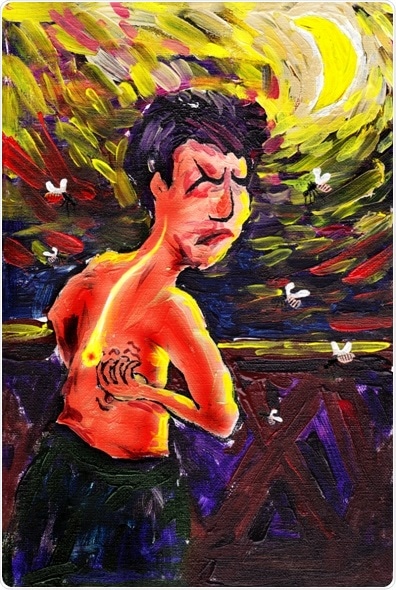Dec 14 2018
It's a maddening cycle that has affected us all: it starts with an itch that triggers scratching, but scratching only makes the itchiness worse. Now, researchers have revealed the brain mechanism driving this uncontrollable itch-scratching feedback loop. In a study publishing on December 13 in the journal Neuron, the researchers showed that the activity of a small subset of neurons, located in a deep brain region called the periaqueductal gray, tracks itch-evoked scratching behavior in mice.

The brain amplifies the itch signal at the spinal level. Courtesy of Jing-Tao Miao
Effective treatment for chronic itch is still lacking, which is largely due to our limited knowledge about the neural mechanism of itch. Our study provides the starting point to further decipher how itch is processed and modulated in the brain. Eventually this might lead to the identification of new therapeutic targets."
Senior study author, Yan-Gang Sun of the Chinese Academy of Sciences.
Itching can be triggered by a wide range of causes, including allergic reactions, skin conditions, irritating chemicals, parasites, diseases, pregnancy, and cancer treatments. The itch-scratching cycle can significantly impair quality of life and lead to serious skin and tissue damage. Recent studies have identified specific subtypes of neurons in the spinal itch circuit, including cells that express the gastrin-releasing peptide receptor (GRPR). But relatively little is known about the brain regions involved in itch processing. Sun and his team suspected that the periaqueductal gray could be involved, in part due to its critical and well-known role in processing related sensory information such as pain.
In the new study, the researchers first recorded from periaqueductal gray neurons in freely moving mice that were induced to scratch through injections with either histamine or an antimalarial drug called chloroquine. Itch-induced scratching behavior tracked the activity of a specific set of neurons that produce a neurotransmitter called glutamate and a neuropeptide called tachykinin 1 (Tac1). When the researchers ablated the Tac1-expressing neurons, itch-induced scratching decreased significantly. By contrast, stimulation of these neurons triggered spontaneous scratching behavior, even without histamine or chloroquine, by activating GRPR-expressing neurons in the spinal itch circuit.
Sun says little is known about how the itch circuit evolved, despite its importance for the survival of animals.
Itch sensation plays a key role in detecting harmful substances, especially those that have attached to the skin. As itch leads to scratching behavior, this allows the animal to get rid of the harmful substances. In some cases, the lesion caused by scratching can evoke strong immune responses, which might help to combat the invaded substances."
Yan-Gang Sun
In future studies, Sun and his team plan to investigate which molecules in the Tac1-expressing periaqueductal gray neurons can be targeted by drugs. They will also search for other nodes in the brain's itch network.
These studies will help us design new approaches or develop new drugs for the treatment of patients with chronic itch."
Yan-Gang Sun
Source: https://www.cell.com/